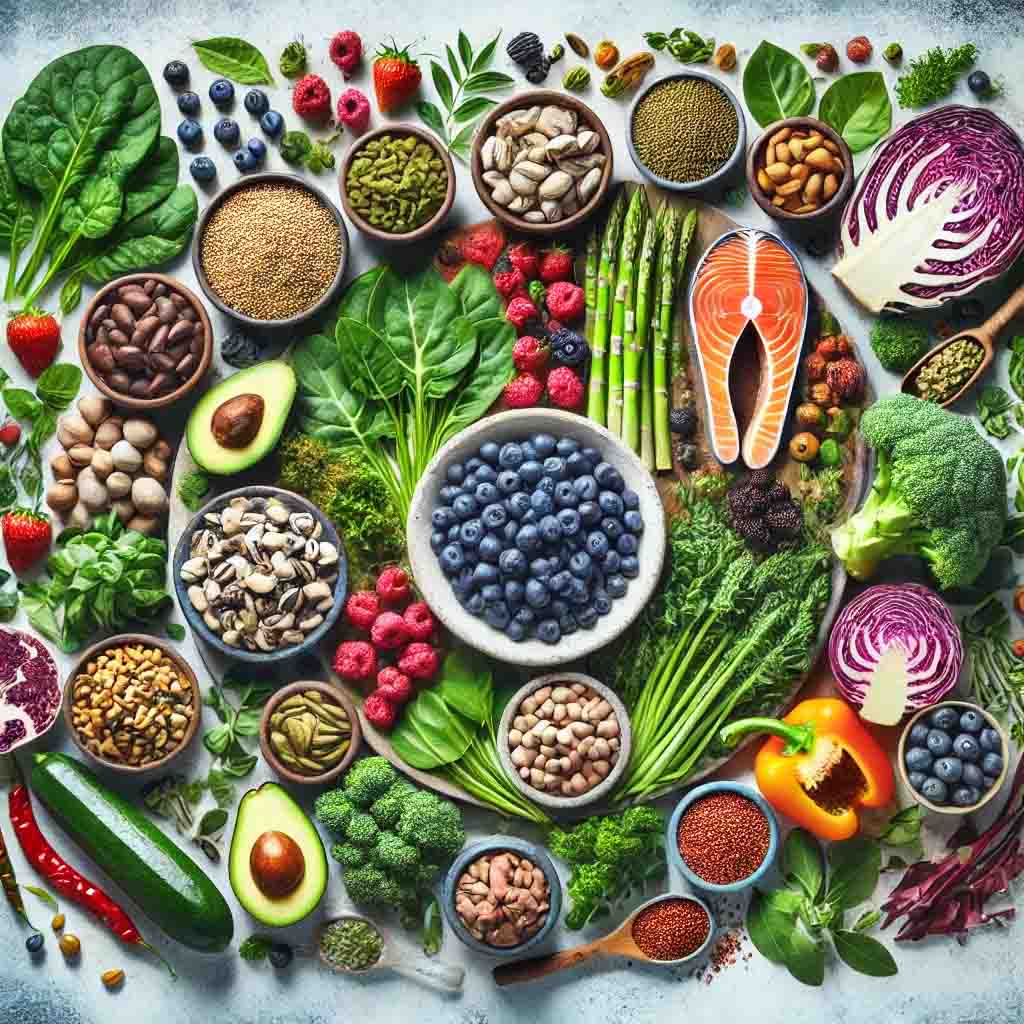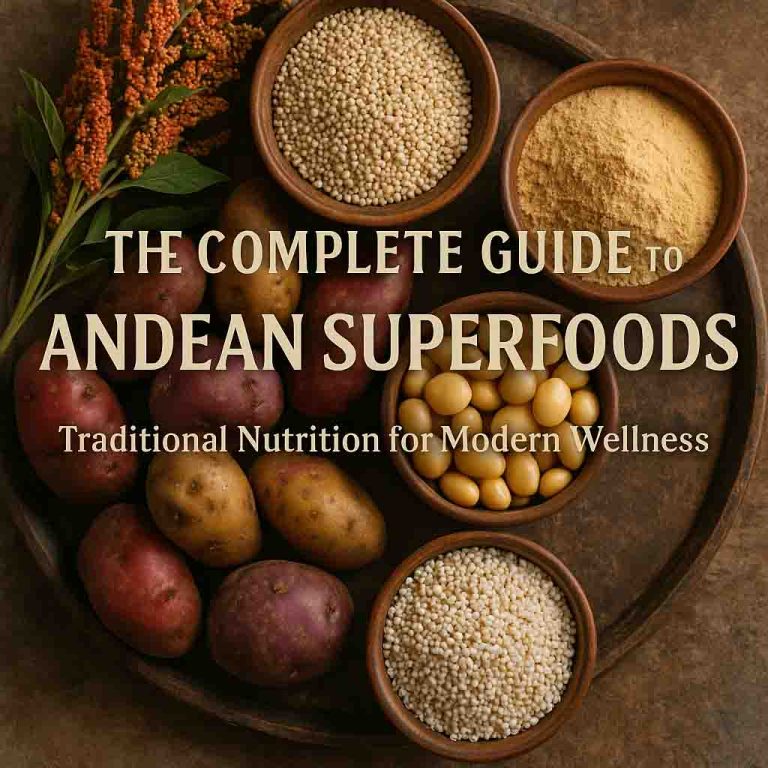9 Nutrient-Dense Foods for a Holistic Diet: Health Benefits and Recipes
Did you know that incorporating nutrient-dense foods into your holistic diet can significantly boost your overall health and well-being? It’s true! Focusing on whole, unprocessed foods is a cornerstone of holistic nutrition, offering a wealth of benefits that go beyond just physical health.
By choosing foods rich in essential vitamins, minerals, and antioxidants, you can support your body’s natural functions and promote a balanced lifestyle. Let’s dive into the top 9 nutrient-dense foods that should be on your plate for a holistic diet.
What Are Nutrient-Dense Foods?
Nutrient-dense foods are those that provide a high amount of nutrients relative to their calorie content. These foods are packed with vitamins, minerals, and other beneficial compounds that are essential for maintaining good health.
Unlike processed foods, which are often high in empty calories, nutrient-dense foods offer a wealth of health benefits, making them a crucial component of holistic nutrition. By incorporating these foods into your diet, you can ensure that your body gets the nutrients it needs to function optimally.
Leafy Greens: The Powerhouses of Nutrients

Leafy greens are nutritional powerhouses that serve as a fundamental pillar of a holistic diet. Among these, moringa leaves stand out as a remarkable “superfood.” Packed with vitamins A, C, and E, along with essential minerals like calcium and potassium, moringa leaves also boast a high protein content. Research indicates that incorporating moringa into your diet may help combat inflammation, reduce cholesterol levels, and assist in blood sugar regulation.
The world of leafy greens extends far beyond moringa, offering a diverse array of options to build your nutritional intake. Kale, spinach, and Swiss chard are well-known favorites, but don’t overlook the potential of mustard greens, beet tops, dandelion leaves, and bok choy. These verdant vegetables are rich sources of vitamins A, C, and K, as well as minerals such as iron and calcium.
Many people, myself included, have experienced a tangible increase in energy and overall well-being after increasing their consumption of leafy greens. The beauty of these nutrient-dense foods lies in their versatility – they can be easily incorporated into your diet through various methods, from crisp salads to vibrant smoothies.
For those interested in exploring the culinary potential of moringa leaves, I’ve included a recipe below.
Moringa Stir-Fry with Eggs
Ingredients:
1 1/2 tbsp coconut oil
1 tsp mustard seeds
2 cups moringa leaves, cleaned
1/3 cup grated coconut
1/2 red onion, sliced
2 green chilies, chopped
1/4 tsp turmeric
Salt to taste
2 eggs (optional for non-vegan version)
Instructions:
Heat coconut oil in a pan and add mustard seeds. Once they splutter, add the sliced onions and chilies. Sauté until the onions are translucent.
Add the moringa leaves and stir-fry for a couple of minutes.
Sprinkle turmeric and salt, then cover and cook on low heat until the leaves are tender.
If using, crack the eggs into the pan and scramble them with the leaves.
Stir in the grated coconut and serve hot with rice or as a side dish.
Enjoy!
Berries: Antioxidant-Rich Superstars

Among the vast array of nutrient-dense foods, berries stand out as both delectable and highly beneficial for a holistic diet. Maqui berries, originating from South America, are particularly noteworthy for their exceptional antioxidant profile. These small fruits are rich in anthocyanins, compounds renowned for their anti-inflammatory properties and ability to combat oxidative stress. Research suggests that incorporating maqui berries into one’s diet may contribute to improved cardiovascular health and better blood sugar management.
While maqui berries may be less familiar to some, more common varieties such as blueberries, strawberries, and raspberries also offer impressive nutritional benefits. These colorful fruits are not only naturally sweet but also packed with antioxidants, essential vitamins, and dietary fiber. Their vivid hues are nature’s way of signaling their high nutrient content, making them an excellent addition to any health-conscious eating plan.
Many people find berries to be an easy and enjoyable way to enhance their daily nutrition. A popular method is to incorporate a handful of these flavorful fruits into morning routines, whether sprinkled over oatmeal or mixed into yogurt. This simple habit can provide a significant antioxidant boost to start the day. The natural sweetness of berries allows them to serve as a guilt-free alternative to processed sweets, offering the pleasure of a treat while supporting overall health.
Maqui Berry Cheesecake
Ingredients:
1 1/2 cups coarsely ground almonds
4 medjool dates
1/8 cup + 2 tbsp maple syrup
1/2 cup coconut cream
1 cup raw cashews, soaked
1/4 cup lemon juice
Zest of 1 lemon
1 cup raspberries
2 tbsp Maqui Berry Powder
Instructions:
Combine almonds, dates, and a pinch of salt in a food processor. Press the mixture into the base of a lined cake tin and freeze for 30 minutes.
Blend coconut cream, cashews, lemon juice, zest, and maple syrup until smooth. Pour over the base and freeze for 1 hour.
Blend raspberries with a tablespoon of maple syrup and lemon zest. Pour over the cashew layer and freeze for another hour.
Mix Maqui Berry Powder with remaining cashews and maple syrup, blend until smooth, and pour as the final layer. Freeze for at least 8 hours.
Remove from the freezer 30 minutes before serving.
Enjoy!
Nuts and Seeds: Tiny Nutritional Giants

In the landscape of nutrient-dense foods, seeds and nuts occupy a vital position in supporting a holistic diet. Sacha Inchi seeds, sometimes referred to as Inca peanuts, are particularly noteworthy for their impressive nutritional profile. These seeds are abundant in omega-3 fatty acids, protein, and fiber. Research indicates that incorporating Sacha Inchi seeds into one’s diet may contribute to improved cardiovascular health, better cholesterol levels, and even assist in weight management efforts.
While Sacha Inchi seeds may be less familiar to some, more common varieties of nuts and seeds also offer significant health benefits. Almonds, chia seeds, and flaxseeds, for instance, are often described as nutritional powerhouses due to their concentrated amounts of healthy fats, protein, and fiber. Ground cashews have the added versatility of serving as a dairy-free thickening agent in various recipes, making them a valuable ingredient for those following plant-based diets.
Many health-conscious individuals find that keeping a mixture of nuts on hand provides a convenient and satisfying snack option. This practice ensures easy access to a nutrient-rich food source throughout the day. Additionally, incorporating seeds into meals can enhance both nutritional value and texture, adding a pleasant crunch to dishes.
It’s worth noting that even a modest daily intake of nuts and seeds can have a substantial impact on overall health. Their nutrient density means that small portions can deliver significant benefits, making them an efficient and effective addition to a balanced diet.
Sacha Inchi Energy Bars
Ingredients:
1 cup pitted dates
1/2 cup Sacha Inchi seeds
1/2 cup rolled oats
1/4 cup almond butter
1/4 cup honey
1/4 cup dark chocolate chips
Pinch of sea salt
Instructions:
Blend dates in a food processor until they form a paste.
Add Sacha Inchi seeds, oats, almond butter, honey, and salt. Blend until well combined.
Stir in chocolate chips by hand.
Press the mixture into a lined baking dish and refrigerate for at least 2 hours.
Cut into bars and store in an airtight container.
Whole Grains: The Foundation of a Balanced Diet

Nutrient-Rich Ancient Grains: Powering Your Holistic Diet
Teff: Ethiopia’s Nutritional Treasure
Teff, an ancient grain hailing from Ethiopia, boasts an impressive nutritional profile. This tiny powerhouse is packed with protein, fiber, and essential minerals such as calcium and iron. Teff’s gluten-free nature makes it an excellent choice for those with dietary restrictions. Studies suggest it may contribute to improved digestive health and provide sustained energy throughout the day.
Whole Grains: The Pillars of Balanced Nutrition
Whole grains form the cornerstone of a well-balanced diet. Quinoa, brown rice, and oats stand out as nutritional champions. These grains are rich in essential carbohydrates, fiber, and B vitamins. By incorporating whole grains into your meals, you’re not only fueling your body but also promoting a feeling of fullness that lasts longer.
Amaranth: The Resurgent Superfood
Amaranth, once forgotten, is now reclaiming its place in modern kitchens. This nutrient-dense grain is a treasure trove of protein, fiber, and various micronutrients. Its versatility in cooking makes it a valuable addition to any health-conscious diet.
Gardeners, take note: Amaranth’s beauty comes with a caveat. This prolific plant can produce an astonishing 250,000 seeds per plant. While this ensures a bountiful harvest, it requires careful management in your garden. Its self-seeding nature means it can quickly spread to unexpected areas if not monitored.
By integrating these nutrient-rich grains into your daily meals, you’re taking a significant step towards a more holistic and balanced diet. Whether you’re seeking gluten-free options, sustained energy, or simply looking to diversify your nutritional intake, these ancient grains offer modern solutions for optimal health.
Savory Teff Cakes with Tomato RelishIngredients:
1 1/2 cups teff grain
2 1/2 cups water or broth
1 shallot, chopped
1 tsp salt
1 tsp Herbs de Provence
Olive oil for frying
1 cup cherry tomatoes, halved
1/4 cup chopped parsley
1 tbsp balsamic vinegar
Instructions:
Cook teff in water with shallots, salt, and herbs until it forms a thick porridge. Pour into a greased baking dish and refrigerate until firm. Cut into squares and pan-fry in olive oil until crispy. Mix tomatoes, parsley, olive oil, and balsamic vinegar for the relish. Serve teff cakes topped with tomato relish.
Legumes: Protein-Packed Powerhouses

Protein-Packed Legumes: Nourishing Your Body and the Earth
Bambara Ground Nuts: Africa’s Hidden Nutritional Gem
Bambara ground nuts, a lesser-known legume from Africa, are nutritional powerhouses. These resilient nuts are packed with protein, fiber, and essential amino acids. Their drought-resistant nature makes them an ideal crop for challenging climates. Remarkably, Bambara ground nuts also contribute to soil health, enhancing fertility wherever they grow. This dual benefit makes them a sustainable choice for both nutrition and agriculture.
Legumes: Versatile Staples for a Balanced Diet
Lentils, chickpeas, and black beans are nutritional stars in the world of legumes. They offer a rich source of plant-based protein, dietary fiber, and crucial minerals. These versatile ingredients can transform your meals. From hearty soups to refreshing salads, legumes add both nutrition and satisfaction to your plate.
Personal Experience with Legumes
I recall my first attempt at making a chickpea salad. It was a culinary revelation that changed my lunch routine. The combination of flavors and textures, coupled with the nutritional benefits, made it an instant favorite. This experience opened my eyes to the vast potential of legumes in everyday cooking.
Incorporating these nutrient-dense legumes into your diet can significantly boost your overall health. Whether you’re exploring exotic options like Bambara ground nuts or relying on kitchen staples like lentils and chickpeas, legumes offer a delicious path to better nutrition. Their versatility in the kitchen means you can enjoy their benefits in countless ways, making every meal an opportunity for nourishment.
Bambara Bean Stew
Ingredients:
2 cups pre-cooked Bambara beans
1 onion, chopped
2 garlic cloves, minced
1 bell pepper, chopped
2 tomatoes, chopped
1 tsp cumin
1 tsp paprika
1/2 tsp chili powder
1 cup vegetable stock
1 cup coconut milk
Salt and pepper to taste
Fresh spinach
Instructions:
Sauté onions and garlic in oil until soft. Add bell pepper and tomatoes, cook until tomatoes break down.
Stir in spices, Bambara beans, stock, and coconut milk. Simmer for 20 minutes.
Add spinach and cook until wilted. Season with salt and pepper.
Serve hot with rice or bread.
Fatty Fish: Omega-3 Rich Delights

Omega-3 Rich Fish: Nourishing Your Heart and Brain
Blue Shark: An Uncommon Source of Essential Fatty Acids
Blue shark, though not a common dietary choice, offers significant nutritional benefits. This oily fish is abundant in omega-3 fatty acids, particularly EPA and DHA. These essential nutrients play a crucial role in supporting heart and brain health. However, caution is warranted. As a larger fish species, blue shark may contain higher levels of mercury. Moderation and awareness are key when incorporating it into your diet.
Fatty Fish: Staples for Optimal Health
More familiar options like salmon, mackerel, and sardines are nutritional powerhouses. These fatty fish are rich sources of omega-3 fatty acids and high-quality protein. Their nutritional profile makes them invaluable for maintaining cardiovascular health and cognitive function.
Incorporating Fatty Fish into Your Diet
Health experts often recommend consuming fish at least twice a week. A simple yet delicious way to prepare fish is grilling them with a squeeze of fresh lemon. This preparation method enhances their natural flavors while preserving their nutritional value.
The benefits of omega-3 rich fish are too significant to overlook. Eating fish regularly can contribute to improved heart health, better brain function, and overall well-being. Whether you opt for more exotic choices like blue shark or stick to popular options like salmon, incorporating fatty fish into your diet is a smart move for your health.
Remember, when it comes to fish consumption, variety is key. This approach ensures a broad spectrum of nutrients while minimizing potential risks associated with any single species.
Grilled Blue Shark with Lemon Herb Butter
Ingredients:
4 blue shark steaks
2 tbsp olive oil
Salt and pepper to taste
1/4 cup butter, softened
Zest of 1 lemon
2 tbsp chopped fresh herbs (parsley, dill)
Instructions:
Brush shark steaks with olive oil and season with salt and pepper.
Grill on medium-high heat for 4-5 minutes per side.
Mix butter with lemon zest and herbs. Serve over grilled shark.
Cruciferous Vegetables: Detoxifying Champions

Kohlrabi: A Versatile and Nutrient-Rich Vegetable
Kohlrabi, a member of the cabbage family, is a cruciferous vegetable known for its high vitamin C, fiber, and potassium content. It supports immune health, aids digestion, and possesses anti-inflammatory properties. Kohlrabi is rich in antioxidants such as anthocyanins, isothiocyanates, and glucosinolates, which help protect cells from free radical damage and may reduce the risk of chronic diseases like heart disease and cancer.
How to Enjoy Kohlrabi
Kohlrabi can be enjoyed in various ways:
– Raw: Slice it thinly (julienne)and add to salads or slaws for a crunchy texture.
– Roasted: Toss with olive oil, garlic, and Parmesan cheese, then roast until tender.
– Sautéed: Cook with onions and garlic for a flavorful side dish.
– Mashed: (my favorite) Combine with potatoes for a healthier version of mashed potatoes.
Brussels Sprouts: A Powerhouse of Nutrients
Brussels sprouts are another cruciferous vegetable packed with fiber, vitamins, minerals, and antioxidants. They are particularly high in vitamin K, which is essential for blood clotting and bone health, and vitamin C, which supports immune function and tissue repair. The high fiber content of Brussels sprouts aids in digestion and promotes gut health.
Cooking Brussels Sprouts
Brussels sprouts are incredibly versatile and can be prepared in numerous ways:
– Roasted: Toss with olive oil, salt, and pepper, and roast until crispy. Enhance the flavor with a drizzle of balsamic vinegar or lemon juice and a sprinkle of Parmesan cheese.
– Sautéed: Add to pasta dishes or stir-fries for a nutritious boost.
– Boiled or Steamed: Serve as a simple side dish with a squeeze of lemon.
– Raw: Shred and toss into salads for a fresh, crunchy element.
By incorporating kohlrabi and Brussels sprouts into your diet, you can enjoy their numerous health benefits while adding variety and flavor to your meals. These nutrient-dense vegetables are perfect for a holistic diet, providing essential vitamins, minerals, and antioxidants that support overall health and well-being.
Kohlrabi Slaw
Ingredients:
2 kohlrabi, peeled and julienned
1 carrot, julienned
1 apple, julienned
1/4 cup yogurt
1 tbsp champagne vinegar or apple cider vinegar
1 tbsp honey or maple syrup
Salt and pepper to taste
Instructions:
Combine kohlrabi, carrot, and apple in a bowl.
Mix yogurt, vinegar, honey, salt, and pepper in a small bowl.
Toss the vegetables with the dressing and serve chilled.
Avocados: Creamy Nutrient Boosters

Lucuma: A Sweet and Nutritious Fruit
Lucuma is a fruit native to Peru and other parts of South America, often used as a natural sweetener due to its unique flavor and lower glycemic index compared to regular sugar. It is rich in antioxidants, fiber, and essential vitamins and minerals, making it a nutritious addition to the diet. Lucuma has been associated with various health benefits, including improved skin health and reduced inflammation, thanks to its high antioxidant content, such as polyphenols and carotenoids.
How to Use Lucuma
– Natural Sweetener: Lucuma powder can be used as a healthier alternative to sugar in baked goods, smoothies, and desserts.
– Nutritional Boost: Add lucuma to yogurt or cereal for added sweetness and nutritional value.
Avocados: A Creamy and Nutritious Delight
Avocados are well-known for their creamy texture and rich nutrient profile. They provide healthy monounsaturated fats, fiber, and essential vitamins and minerals, such as vitamins C, E, K, and several B vitamins, including folate. Avocados are also high in potassium and antioxidants, which contribute to heart health and help reduce inflammation[1][3][5].
Delicious Ways to Enjoy Avocados
– Mashed Avocado Toast: Mash avocados with garlic and lemon juice, spread on toast, and top with a poached egg and a sprinkle of tarragon for a delicious breakfast.
– Smoothies: Blend avocados into smoothies for a creamy texture and nutrient boost.
– Versatile Ingredient: Avocados pair well with both sweet and savory dishes, making them a versatile addition to any meal.
Both lucuma and avocados are nutritious foods that can enhance your diet with their health benefits and versatility in various culinary applications.
Lucuma Mousse
Ingredients:
1 1/2 cups lucuma puree
1 cup heavy cream
3 egg yolks
1/2 cup Panela (unrefined cane sugar, read about it here)
1/4 cup water
Instructions:
Beat cream until soft peaks form, refrigerate.
Boil Panela and water to make syrup. Beat egg yolks and slowly add syrup, beating until cool.
Fold in lucuma puree and whipped cream.
Chill for at least 6 hours before serving.
Fermented Foods: Gut Health Enhancers

Natto: A Nutrient-Packed Fermented Soybean Product
Natto is a traditional Japanese food made from fermented soybeans. It is particularly rich in probiotics and vitamin K2, both of which are essential for maintaining good health. Vitamin K2 plays a crucial role in bone health by aiding calcium absorption and also supports cardiovascular health by preventing arterial calcification. The probiotics in natto contribute to improved digestion and a balanced gut microbiome, which are important for overall well-being.
Health Benefits of Natto
– Bone Health: The high vitamin K2 content in natto supports bone density and strength.
– Cardiovascular Health: Natto may help reduce the risk of heart disease by improving blood vessel function.
– Digestive Health: The probiotics in natto promote a healthy gut microbiome, enhancing digestion and nutrient absorption.
Fermented Foods: A Boost for Gut Health
Fermented foods like yogurt, kefir, and sauerkraut are excellent for supporting gut health and digestion. These foods are rich in probiotics, which help maintain a healthy balance of gut bacteria. A balanced gut microbiome is crucial for overall health, influencing everything from digestion to immune function and even mental health.
Incorporating Fermented Foods into Your Diet
– Daily Serving: Aim to include a serving of fermented foods in your diet each day. This could be a spoonful of yogurt with breakfast or a side of sauerkraut with dinner.
– Variety: Experiment with different fermented foods to enjoy a range of flavors and health benefits.
Including natto and other fermented foods in your diet can significantly enhance your gut health and overall well-being, thanks to their rich probiotic content and other essential nutrients.
Natto Sushi Roll
Ingredients:
1 cup sushi rice, cooked
2 sheets nori
1 pack natto
1 cucumber, julienned
1 avocado, sliced
Tamari or Soy sauce for serving
Instructions:
Spread rice over nori sheets, leaving a border.
Spread natto over rice, then add cucumber and avocado.
Roll tightly and slice into pieces.
Serve with soy sauce.
Conclusion
Incorporating these nutrient-dense foods into your holistic diet can have a profound impact on your health and well-being. By focusing on whole, unprocessed foods, you’re providing your body with the essential nutrients it needs to thrive.
Obviously, not everyone will have access to all or even any of the main ingredient. Substitute with others in the same group and live on the dangerous side. Eat healthy, try something new. I encourage you to start adding these foods to your meals and experience the benefits for yourself.
For those interested in living a more holistic lifestyle I invite to read the article Holistic Living Tips here.




